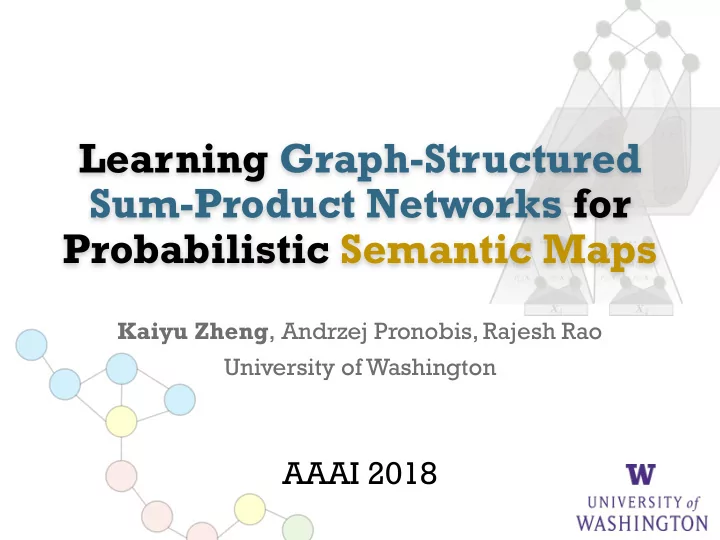

Learning Graph-Structured Sum-Product Networks for Probabilistic Semantic Maps Kaiyu Zheng , Andrzej Pronobis, Rajesh Rao University of Washington AAAI 2018
Motivation (Robotics) Mobile Robots in Indoor Spaces Learning Graph-Structured Sum-Product Networks for Probabilistic Semantic Maps
Motivation (Robotics) Semantic Maps Learning Graph-Structured Sum-Product Networks for Probabilistic Semantic Maps
Motivation (Robotics) Semantic Mapping Inferred distributions of latent variables (semantic attributes) Local evidence spatial places relations (entities) Learning Graph-Structured Sum-Product Networks for Probabilistic Semantic Maps
Motivation (Robotics) Problelm : Learn general spatial relations between things in the world Estimate semantic attributes in specific environment? • Model semantic map as a whole • This is Structured Prediction (SP) spatial places relations Learning Graph-Structured Sum-Product Networks for Probabilistic Semantic Maps
Motivation (Machine Learning) Probabilistic Graphical Models Pros: Cons: • Probabilistic • Intractable exact inference • Generative • Interpretable Examples: Bayesian Network, Markov Random Field, Chain Graph [Pronobis&Jensfelt ICRA’12] Learning Graph-Structured Sum-Product Networks for Probabilistic Semantic Maps
Motivation (Machine Learning) Recent Deep Structured Prediction Approaches • End-to-end • Remarkable results for visual data [Schwing & Urtasun , ICML’15, Belanger & McCallum, ICML’16, Figure from [Shelhamer et. al. PAMI’16] Shelhamer et. al. PAMI’16] Learning Graph-Structured Sum-Product Networks for Probabilistic Semantic Maps
Motivation (Machine Learning) Recent Deep Structured Prediction Approaches • But… • Strict constraints on variable interactions • Fixed number of variables • Static global structure • Often not probabilistic [Schwing & Urtasun , ICML’15, Belanger & McCallum, ICML’16, Shelhamer et. al. PAMI’16] Learning Graph-Structured Sum-Product Networks for Probabilistic Semantic Maps
Sum-Product Networks • Viewed in 2 ways: • Deep architecture • Graphical model • Structure semantics: • Hierarchical mixture of parts Latent Variable Input Variables Learning Graph-Structured Sum-Product Networks for Probabilistic Semantic Maps
Sum-Product Networks P(X 1 , X 2 ) Sum (Mixture Model) 0.5 Weights (Priors) 0.3 0.2 Product (Compositions of Parts) Low-level Features 0.8 0.7 0.5 0.4 0.2 0.3 0.5 0.6 Naïve Bayes Mixture Model • 3 components X 1 X 1 X 2 X 2 Input Variables • 2 binary variables [Poon & Domingos , UAI’11, Friesen & Domingos , ICML’16]
Sum-Product Networks • Learn conditional or joint distributions • Tractable partition function, exact inference [Poon & Domingos , UAI’11, Friesen & Domingos , ICML’16]
Proposed Method Graph-Structured Sum-Product Networks • Template-based approach • Defined as a set of template SPN models • Template models represent general , higher-order relations between latent variables • Applied to form a single distribution for a specific structured problem for inference Learning Graph-Structured Sum-Product Networks for Probabilistic Semantic Maps
Learning General Knowledge Graph-Structured Sum-Product Networks GraphSPN Template 1 Template 1 Partition Train Template N Template N Annotated Sub-graphs training data Template SPNs (graph-structured) Learning Graph-Structured Sum-Product Networks for Probabilistic Semantic Maps
Instantiation for Specific Problem Graph-Structured Sum-Product Networks Learning Graph-Structured Sum-Product Networks for Probabilistic Semantic Maps
Learning Graph-Structured Sum-Product Networks for Probabilistic Semantic Maps
Learning Graph-Structured Sum-Product Networks for Probabilistic Semantic Maps
Experiments GraphSPN for Semantic Mapping Observed local evidence Learning Graph-Structured Sum-Product Networks for Probabilistic Semantic Maps
Observed local evidence Learning Graph-Structured Sum-Product Networks for Probabilistic Semantic Maps
P(Y i ) Inferred distribution of latent variables (Semantic place categories) Observed local evidence Learning Graph-Structured Sum-Product Networks for Probabilistic Semantic Maps
Experiments Dataset • 99 semantic maps of 11 floors in 3 buildings in different cities • Cross-validation: • Trained on graphs from 2 buildings • Tested on graphs from remaining building Learning Graph-Structured Sum-Product Network for Probabilistic Semantic Maps
Experiment 1 Infer Latent Semantics based on Noisy Evidence local evidence Node associated with incorrect evidence (20%) correct class incorrect class Node associated with correct evidence (80%) local evidence correct class noise Learning Graph-Structured Sum-Product Network for Probabilistic Semantic Maps
Experiment 1 Infer Latent Semantics based on Noisy Evidence output Correction of incorrect information (20%) correct class incorrect class Strengthen correct information (80%) output correct class Learning Graph-Structured Sum-Product Network for Probabilistic Semantic Maps
Experiment 1 Results: Inference Behavior GraphSPN Groundtruth Noisified Similar results even without local evidence for some places
Experiment 1 Results: Increasing Noise Freiburg Saarbrücken Stockholm Accuracy (%) → GraphSPN MRF (order 2) MRF (order 3) Noise Level → Learning Graph-Structured Sum-Product Networks for Probabilistic Semantic Maps
Experiment 2 Novelty Detection See paper for more details office doorway Regular corridor doorway Novel office corridor Learning Graph-Structured Sum-Product Networks for Probabilistic Semantic Maps
Conclusions • Introduced GraphSPNs • Leverages Sum-Product Networks General approach Complex, noisy Inference based to model arbitrary variable on instantiaion of dynamic graphs dependencies template models • Applied GraphSPNs to model semantic maps Learning Graph-Structured Sum-Product Network for Probabilistic Semantic Maps
Ongoing Work Unified Model for Spatial Knowledge Unified Model Semantics in global context GraphSPN This work! Global topology Local place DGSM semantics (Pronobis and Rao, Sensory IROS 2017) information Learning Graph-Structured Sum-Product Network for Probabilistic Semantic Maps
Learning Graph-Structured Sum-Product Networks for Probabilistic Semantic Maps Kaiyu Zheng , Andrzej Pronobis, Rajesh Rao University of Washington http://www.kaiyuzh.me http://www.pronobis.pro Thank you
Recommend
More recommend